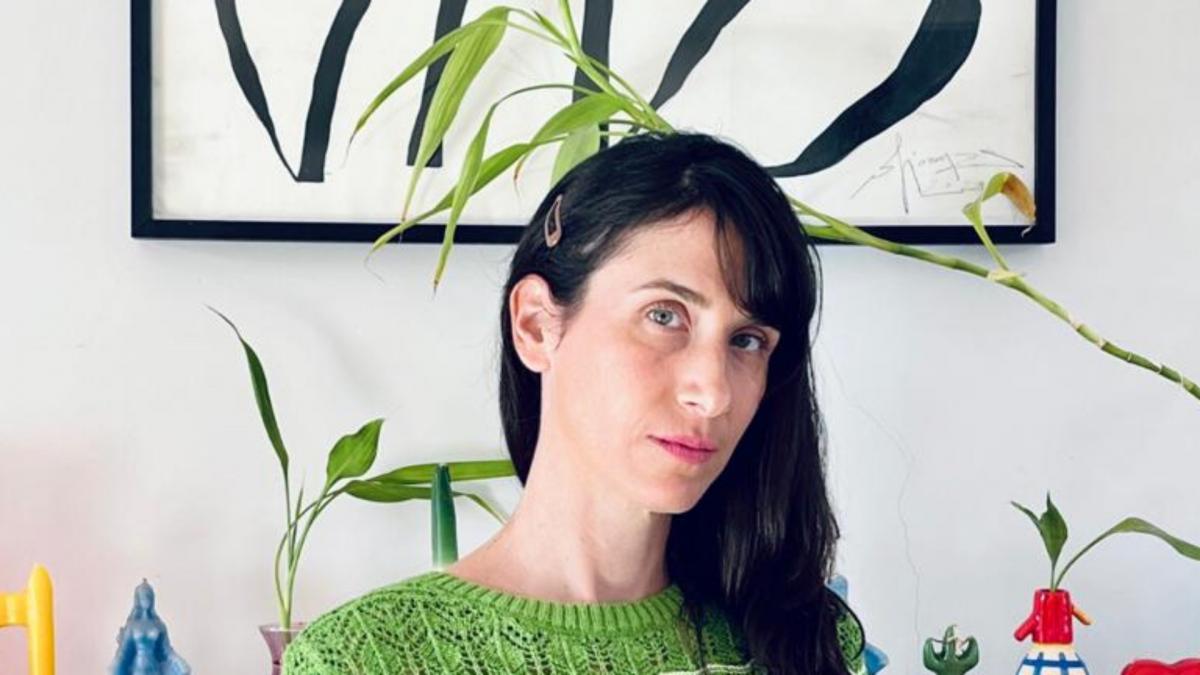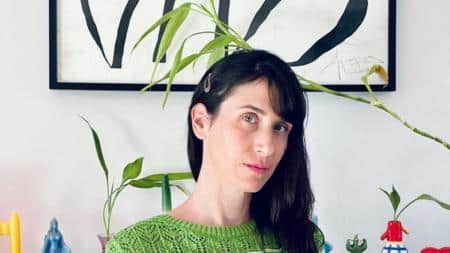 Natalie Aboud, director and narrator. /Photo: press.
Natalie Aboud, director and narrator. /Photo: press.
With a title reminiscent of cinematic adventures and a strong, unprejudiced narrative voice, “Sierra Nevada” is the first novel by writer and theater director Natalí Aboud.
It tells the story of a loss and the journey that the protagonist undertakes to mitigate the pain. A journey that takes her to paradisiacal places, but also makes her go deep inside herself to return renewed. “Losses leave space for transformation to take place,” reflects Agostina Luz López on the back cover.
Natali Aboud was born in Buenos Aires in 1986. She is a writer, director and theater producer. She is currently studying a Bachelor of Arts in Writing at the National University of the Arts. He wrote and directed plays such as “El Guerrero Amable” and “Every day I am bored and cry” and currently “Early Diaries”. He published “In retirement people are happier” in an Anthology of Short Stories by Evaristo Editorial (2019); “Diario de Esays” is part of the book Como un espejo by Agostina Luz López (2021), published by Mansalva editorial and a fanzine of poems “Las Aventura del Ángel de Plumas”.
“Sierra Nevada” is his first novel and he talked about it with Télam in this interview.
-Télam: Do you perceive that there is a boom in “memoires” or autobiographical texts? Some publishers even inaugurated collections dedicated to the literature of the “I”…
-Natali Aboud; Yes. Ediciones B arose from Random House where Jacqueline Golbert (editor of Founding Partners), has just published her book. I love this “boom”, because this type of literature motivates me and it’s good that I have a special collection.
In the case of “Sierra Nevada”, the autobiography was a kick to immerse myself in fiction. At the time I wrote the novel, I was going to Cérebro Magnético, a party that was held in a commercial gallery. That space inspired me to start writing. Those ties that only exist at night, and during the day they disappear. That dancing ensemble that is created between vibrations and gestures. The protagonist of the novel lives the holidays as an experience of expansion, of being part of a rite It’s not just entertainment, it’s something deeper, a safe place of belonging, a home, the adventures that are lived in a single night, a night that is like a trip.
 The author discusses losses and strategies to mitigate grief. /Photo: press.
The author discusses losses and strategies to mitigate grief. /Photo: press.
-T.: Was it just that circumstance, the party as a starting point?
-NA; Later the text was expanded when I added accounts of the experience I had with my cat when she fell ill, and in the novel I decided that the protagonist’s cat should die, something that had not yet happened in my life. That impulse to kill my cat in fiction was what showed me the path where the story was going to take root. I felt free and empowered: to write what I wanted without knowing where it would go, losing myself in fantasy, being, above all, faithful to my intuition.
-T.: What is the attraction that the first person has for the reader?
-NA; The first person makes you be close to the narrator. As a reader you generate instant intimacy, it is as if she were your friend who tells you everything that is happening minute by minute. It is a way of getting to know the protagonist very closely. In the case of Sierra Nevada, it is a first person who narrates in the present, the reader learns about the events and feelings at the same time as the protagonist, makes us witnesses of what he is experiencing.
It is an impulsive voice with the desire to experience everything and an urgency to tell what it is experiencing, without distance to process. A girl who narrates humid and tropical adventures. She is carried away by a burning desire, a clumsy and reckless passion to go in search of the limit, where dream and reality mix, like the edges between the repulsive and the beautiful. The sudden passages from one story to another, the ellipses seek an effect of dizziness, of plot overdose, just like the one suffered by the protagonist in her mind.
-T.: What happens to the protagonist with her affections?
-NA; They are intense and fleeting relationships: “night friends”, that’s how she defines them. People who show up to give you a key that opens a portal and then leave. Links as excuses to experiment and discover herself. The character is also obsessive, watching her friends closely and describing them with exhaustive, detective-like precision. On the other hand, there is her bond with her mother, a safe place where she can always return and, in turn, discover in her the passage of time. Her old age that she approaches her showing her that she is no longer a girl, but two adults who are accompanied by her.
-T.: On the back cover, Agostina Lòpez says that losses leave room for transformation? Is the death of the protagonist’s kitten what moves her to the trip?
-NA; Yes, that hole left by the death of Brownie his cat is what mobilizes the trip. These ties with animals can become very deep and in this case, for the protagonist, the cat represents a form of family, of mutual care. After her death, something of her is broken in her life and her house becomes a hurtful place that only shows her absence, it is no longer a home. She goes looking for that home and I think she finds it in the links.
-T.: What sense does the journey have in the life of the protagonist?
-NA; A search to go into the unknown, to collapse and rebuild. An explorer who allows herself to be traversed by the landscape, the animals, the beings she meets along the way. She wonders what her purpose is on this trip and she has no answer. I believe that uncertainty and not knowing, abandoning herself, is the true meaning of the trip.
-T.: What do the different parts respond to, changes in the protagonist’s life?
-NA; It is structured in three parts that represent three different forms of liberation, of getting out of oneself, and this is achieved, albeit imaginarily, through ecstatic procedures (parties/drugs, sex, poison, the mystical, death). As Néstor Perlongher says in Anthropology of ecstasy: ¨The word ecstasy indicates displacement, change, deviation, alienation, disturbance, delirium, stupor, excitement caused by intoxicating drinks.¨ In ecstasy one escapes, to a certain extent, from its conditions of existence. The protagonist of Sierra Nevada seeks to escape from herself and makes a passage from freeing her desire to freeing herself from all desire.
The parts of the novel also correspond to a movement and a jump in time, the protagonist moves from the city to nature, from a party in a business gallery in downtown Buenos Aires to a cave in the middle of the Colombian jungle, from falling in love to abandonment, from being cared for by her mother to being the one who cares now, a passage from youth to adulthood.
-T.: Is Sierra Nevada an initiation trip?
-NA; I think it is a journey to escape pain, to die and be reborn, a thousand times, and in that sense it could be read as an initiation journey, where there is a process of transformation, although in this case, although the protagonist undergoes changes, when she returns to her city after the trip, what is transformed is her environment. Ana Montes in the presentation of the novel said: ¨Sierra Nevada could be read, with the naked eye, as a journey of initiation. But if in a classic initiation journey the character has to go to an unknown place to live an adventure, in this novel the protagonist’s journey begins long before leaving the city.¨
partners for culture
“Sierra Nevada” was published by the independent label Socios Fundadores, which has a catalog of more than 20 titles, distributed by Blatt & Ríos.
“Working with them was a very enriching process for me. There was a lot of love and dedication in the process. From the meetings we had with Martina Juncadella (editor) to correct and think, to the decisions for the cover role – recalls Aboud-. Socios Fundadores is a friends’ publishing house and for me working with friends is the most beautiful thing in the world. It generates a freshness and fun that are reflected in the novel”.
For her part, Jacqueline Golbert, one of the “partners” of the publishing house, tells that she met the other two promoters of the project Pablo Petkovsek and Martina Juncadella in Cecilia Pavón’s poetry workshop: “We started to make friends through poetry and one day Martina proposed to me to have a publishing house. We had no idea how it was done but we knew it was our project.”
They started with the texts of their classmates that they liked and with their own texts:
“The publishing house is experimental and the genres are hybrid. They mix narrative and poetry”, points out the editor, who is also a journalist and bookseller.
Goldberg remembers that the first covers of the books were made by themselves with collage. This was the case with Deep Down, a mix between narrative and poetry by Sara Moss, a Canadian who lives in Buenos Aires. “We got some animal figurines and cut the covers with a square that allowed us to see the inside,” she details, pointing out that that book is sold out.
Later they began to include visual artists for the different covers, but the first fifteen books were printed at home with a printer and fastened in a neighborhood printer. “Until we decided to stop being so niche and dialogue with other audiences, so now we have it printed by a printer and we have distributed Blatt and Ríos,” Goldberg is proud and tells that the next book is a collection of poems by Valentín Etchegaray, a boy he met in Cecilia Pavón’s workshop.


